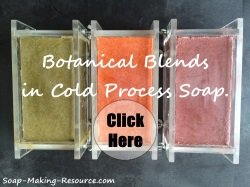Lard Soap Making
Many love using lard for soap making to add a creamy lather, conditioning properties and some hardness to the finished product. Although it does add beneficial properties to your soap, you need to be aware that it is not great for your label appeal. In fact, some people will avoid your products all together if they see that you use lard, or any other animal fat! On the other side of the spectrum, some consumers and soap makers love lard soap and will use and make nothing else!
I happen to be an all veggie soap maker as I am a striving vegan, so I can't really offer what I've learned through my personal experience when it comes to lard soap making. I can however, tell you what I've learned from other soap makers and through my own personal research.
|
Sign Up Today!
*Your information is SAFE with us! |
First let's take a look at the fatty acid, iodine and SAP values for lard:
| Lauric | 0% |
| linoleic | 6% |
| linolenic | 0% |
| Oleic | 46% |
| Palmitic | 28% |
| Ricinoleic | 0% |
| stearic | 13% |
| myristic | 1% |
| Iodine Value | 57 |
| SAP Value Sodium Hydroxide | .141 |
| SAP Value Potassium Hydroxide | .198 |
Here are some of the characteristics that you will see within your product when using lard for soap making:
| Bubbly lather | No |
| Creamy/Stable lather | Yes |
| Cleansing | Mild |
| Conditioning | Yes |
| Hardness | Yes |
I recommend that you add other soap making oils that offer better cleaning abilities and more bubbly lather to make up for what lard lacks. A little bit of castor oil will take care of the suds and some coconut oil or palm oil will make your bar clean much better.
Let me stifle a common myth that even I used to believe about lard soap. Some people wrongly assume that lard soap will clog pores and damage the skin. This is not true. Lard may actually benefit the skin because it is mild, moisturizing, and conditions very well.
I think that consumers unfortunately associate lard and other animal fats with store bought commercial soaps that incorporate skin damaging chemicals. They don't realize that it's the synthetics damaging the skin, not the lard.
Don't get me wrong, lard can cause damage to the skin for some people, just like any other soap oil can. It all depends on you! Some people react badly to shea butter, while others react poorly to olive oil. That being said, of course you will get the occasional consumer who will report negative skin effects from lard. It's bound to happen!
Keep in mind that most people will be fine with pretty much any natural soap making oil. There are, however, a few people out there who suffer from EXTREMELY sensitive skin and will have negative reactions to just about anything. There's nothing you can do about it except for clearly marking your labels which allows your consumer to make their own judgment as to what they put on their skin.
Remember that lard is not the same as tallow and won't produce soap with identical characteristics as some beginners tend to assume. First of all, lard is fat from a pig while tallow is usually fat taken from around the loins and kidney of a cow. therefore, The fatty acid makeup is different as they are two completely unique substances!
There are, of course, other types of tallow like deer tallow or sheep tallow etc. Many report that using tallow for soap making will produce a harder bar that lathers better while using lard for soap making will produce a softer bar with nicer conditioning properties. Remember that lard and tallow usually needs to be rendered before it can be used to make soap!
Return from lard soap making to the soap making ingredients main page.











